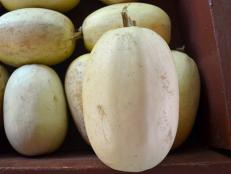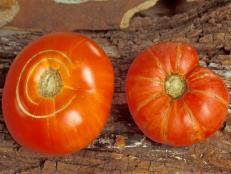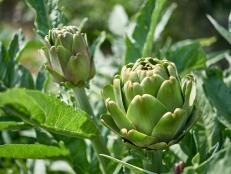Squash Bugs and Squash Vine Borers in the Garden
Having problems with your squash plants? It might be squash bugs or squash vine borers. Both can cause significant damage to squash, gourds, pumpkins and zucchini plants. Learn how to detect these pests and preserve your crops.

Squash, in all its different varieties, is a must-have vegetable in many kitchen gardens, but gardeners often face two challenges as the prolific vines grow and produce: squash bugs and squash vine borers.
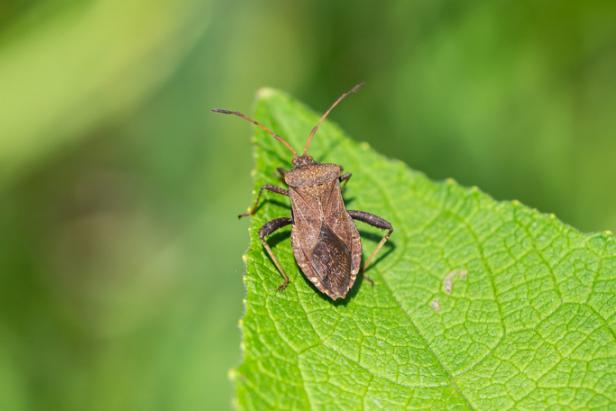
Shutterstock/Erik Agar
Squash bugs are flat, dark-brown or gray insects that measure about 5/8-inch as adults. They crawl over the plants and use their piercing mouthparts to suck the juices out of the leaves and stems.
What Are Squash Bugs and Squash Vine Borers?
Squash bugs are flat, dark-brown or gray insects that measure about 5/8-inch as adults. They crawl over the plants and use their piercing mouthparts to suck the juices out of the leaves and stems.
Squash vine borers are small, clearwing moths that, in their larval stage, burrow into the stems of squash plants and munch their way through the vine, causing them to wilt suddenly, rot and die.
Squash bugs and squash vine borers can both cause significant damage and loss to a gardener’s crop.
How to Tell If You Have Squash Bugs
Squash bugs generally feast on squash plants, but also on other species in the family of cucurbits: cucumbers, melons, pumpkins and gourds.
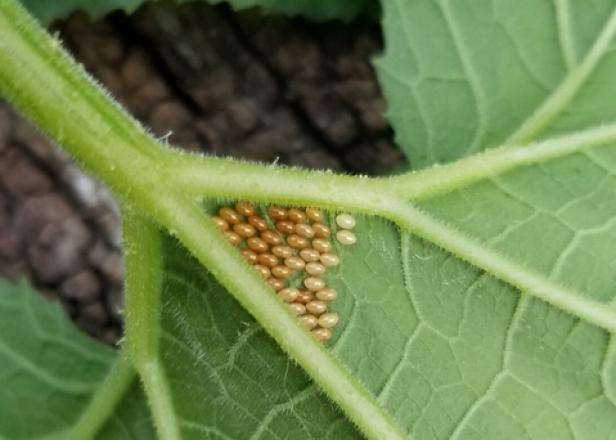
Shutterstock/Andrew Hahn
Squash bugs often lay their eggs between the stems of leaves on a plant.
The first sighting of squash bugs in your garden may be a cluster of small, oval eggs, yellowish to bronze in color and often laid in tidy rows on the undersides of leaves. These will hatch into nymphs in about 10 days, which will grow into adult squash bugs in about four to six weeks. While a squash bug develops only one generation a year, the stages overlap, so it’s likely you may see the bugs throughout the growing season.
The damage they cause is due to their feeding — they suck the sap out of the plant's leaves. You’ll see the damage first as yellow spots on the leaves, which then turn brown and, in severe cases, wilt due to the disruption of the flow of water and nutrients.
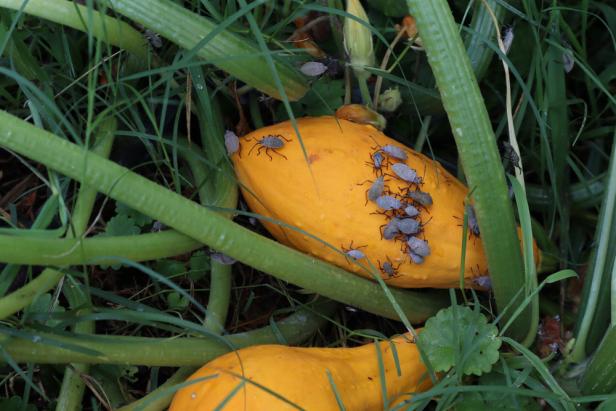
Shutterstock/Gina Santoria
Squash bugs use their piercing mouthparts to suck the juices out of squash leaves, stems and fruit.
How to Get Rid of Squash Bugs
A light infestation of squash bugs is generally not fatal to plants. “It’s when their population starts to get dense is when you start having issues,” says Amy Dunlap, an extension agent with the University of Tennessee Extension. “They certainly can overpower the plant.”
Still, when you find adult squash bugs or clusters of eggs or nymphs on your plants, you’ll want to get rid of them as soon as possible. The adults and nymphs can be flicked off into a bucket of soapy water, but be aware that they can fly away or hide quickly under leaves when disturbed.
The eggs, which often are deposited within the V-shape veins of the leaves, can be carefully scraped off and destroyed. If scraping them off with a fingernail doesn’t sound appealing, one suggested hack is to use the sticky side of a piece of tape to lift them off the plant. “You could also spray them with a heavy stream of water, but it’s probably easier to just scrape them off,” Dunlap says.

Shutterstock/Lulub
Squash bug nymphs use their piercing mouthparts to feed on the leaves of a squash plant, causing damage and eventually killing the plant.
You may also be able to trap squash bugs by laying down boards or sheets of newspaper near the plants. The insects will group under the boards at night, and you can gather and destroy them in the morning.
Manual removal is preferred; insecticides that home gardeners can use are generally not effective against adult squash bugs. The best preventive is to be diligent about keeping the area around your plants clean, Dunlap says. During the growing season, remove any plant debris where squash bugs may hide. The insects overwinter in plant debris in the garden, so at the end of the season clean up remaining plant matter to reduce the number of places where they could find winter shelter.
How to Tell If You Have Squash Vine Borers
The squash vine borer is another problem altogether, and one that’s more difficult to help the plant recover from.
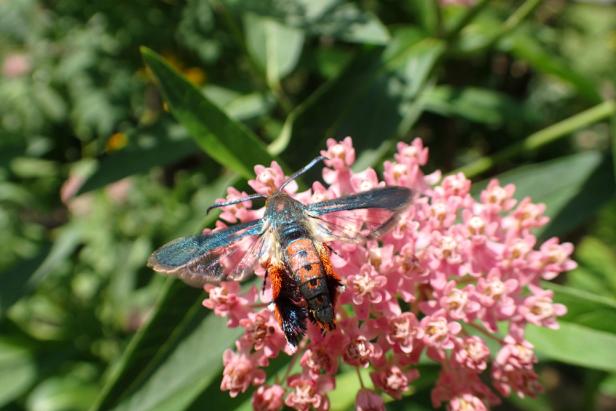
Shutterstock/Dan4Earth
Squash vine borers look like a type of wasp, but they're not so innocent. They can be hard to detect and hard to get rid of. They burrow into plant stems and cut off their supply of water and nutrients.
The culprit is the larva of a clearwing moth that is dark gray with red, hairy back legs. At first glance, it may be mistaken for a type of wasp as it flits around the garden during daylight hours. In late spring or early summer, the adult female moth deposits her eggs singly at the base of the squash plant, and the larvae that emerge about a week later bore into the stems to begin feeding. They tunnel through the stem, an action that blocks the flow of water to the rest of the plant, and the stem quickly wilts.
After the larvae end their feeding four to six weeks later, they leave the stems and burrow into the soil to pupate, where they remain until the following summer. Meanwhile, a large portion — or maybe all — of the plant has died from lack of water and nutrients.

Shutterstock/scott conner
The larvae of a squash vine bore tunnels through the stem, an action that blocks the flow of water to the rest of the plant, and the stem quickly wilts.
How to Get Rid of Squash Vine Borers
Unless you’re inspecting your squash vines every day, the first sign of the borer may be the wilted leaves. If it’s caught early, it may be possible (though not easy!) to save the plant.
As soon as you notice a wilted squash vine, check for holes filled with a moist sawdust-looking substance (this is called frass) at the base of the plant. Cut a slit into the stem with a sharp knife, and carefully slice along the vine until you find the inch-long, cream-colored larva, and remove it. Note: There may be more than one, so check carefully.
After you kill the larvae, mound soil over the cut area. Keep the soil watered to allow the possibility of new roots that may grow along the cut stem, which will help the plant survive.
The adult moths are black and orange, with clear wings. If you notice squash vine borer moths in the garden — typically in June or July — trap them by setting out a container filled with water and a drop or two of dish soap. The moths are attracted to yellow, so a yellow container is best for this task. Check the traps every day.
Placing floating row covers over young plantings can prevent the mature adult moths from laying eggs on the squash vines. Make sure the covers are secure on the ground so that adult moths can’t get under them. Remove the covers as the vines begin to bloom so they don’t interfere with pollination.
Don’t plant squash in the same place two years in a row. After the larvae leave the squash vine, they burrow into the soil to spend the winter, then emerge the following year as adults, ready to start a new generation, so you don’t want to give them a second chance at your squash crop.
As it is for squash bugs, the best control method for squash vine borers in home gardens is prevention. Keep the area clean of plant debris, and clean up remaining plant matter where the insects might overwinter.
Choose Squash Varieties Wisely
No squash plants or other cucurbits are immune to these insects, but there are varieties that are less susceptible, Dunlap says.
Butternut and Royal Acorn squash are generally resistant to squash bugs; Sweet Cheese and Green Striped Cushaw squash are moderately susceptible. Black Zucchini and Pink Banana squash are likely to be sought out by squash bugs, and Hubbard squash is the most preferred by the insects, Dunlap says. Butternut squash is also less susceptible to squash vine borer.
To try to manage the pests on your preferred variety, it’s a good practice to plant a “trap crop” of a highly susceptible variety next to the less-resistant squash. “The bugs are lured to the crop that’s more highly susceptible, and that keeps them off the ones you want,” Dunlap suggests.









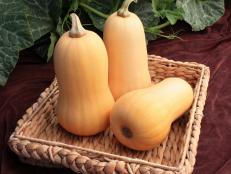
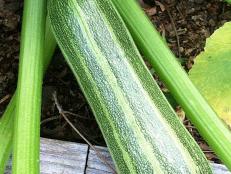
![Homegrown variety of winter squash. Homegrown winter squash. 195956_3603429601142_787136137_n[2].jpg](http://hgtvhome.sndimg.com/content/dam/images/grdn/fullset/2014/2/7/0/195956-3603429601142-787136137-n-2.jpg.rend.hgtvcom.231.174.suffix/1452646912247.jpeg)

